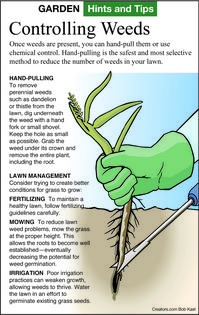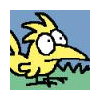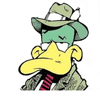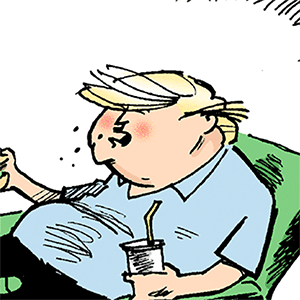The Greener View: Lawn Weeds, Everyone Has Them
Q: My lawn is being overtaken by wild strawberry, which is spreading. The only thing that I have been told to do is to wait until it rains and pull the plants out by hand. Do you have any other organic suggestions to get rid of these plants? I am open to herbicides if that is what it takes.
Q: We have quack grass in our lawn, and it seems to be taking over. How do we get rid of it?
A: If there are not very many weeds, hand-pulling can work if you are persistent enough to do it weekly or twice weekly until they are gone. Actually, hand-pulling weeds is one of the best organic methods of weed control no matter how many weeds there are, though it can be tedious and backbreaking. There are a few long-handled tools that let you get the random dandelion without bending over, but to get rid of large clumps of clover, sit down and pull them out.
Organic and nonorganic weed killers come in three major groups. Those that kill all plants are known as nonselective. Some chemicals only kill grass plants. Finally, some chemicals only kill broad-leafed plants. You need to use only the one that will work on your weed problem. Look at the label to see if the weed you have is listed.
No matter what you choose, follow the directions. Overdosing does not do any good. Usually, an overdose will just burn off the leaves and then the root sends up more, so you accomplish nothing. Repeated small doses are more effective. Several doses may be necessary to get the entire root system.
Weed killers can be granular or liquid. The granular variety works well mixed with fertilizer or when applied over large areas or in windy conditions. Liquid applications work very well for spot applications, mixed with liquid fertilizer, and should only be used when the wind is at a minimum. Early morning and late evening are good times to apply liquid herbicides because the wind is usually calmer and the plants soak it up better.
Weeds can be grass or broad-leaf and annual or perennial. Three of these categories are fairly easy to remove. Both grass and broad-leaf annuals will die at the end of the season. If they can be stopped from flowering and reseeding, they can be prevented from reappearing. The best thing to do for them is to get the lawn grass established and then apply a pre-emergent weed killer in the spring for most of them and in the fall for a few of them.
Pre-emergent weed killers form a chemical barrier on the soil surface that stops plants as they try to sprout up through it. It will last about three months, so two applications in spring and fall will prevent most annual weeds. Disturbing the barrier will allow seeds to sprout and grow. Pre-emergent herbicides will work on perennial seeds, but not the mature plant.
Many broad-leaf weeds grow tall enough to be killed when they are mowed. If not, a broad-leaf weed killer is used as the next step. It should be applied when the plant is actively growing. If the plant is dormant in the summer heat, not much growth will occur, so the weed killer will not have much effect.
Weeds that are both a grass and a perennial such as the quack grass in the question are the toughest to remove from a lawn since lawn grasses are also perennials. They need to be sprayed with a nonselective plant killer, so the spray will also kill the good grass. Limiting the spray's drift will help protect the good grass. A shield can block the spray and keep it only on the clump of weed grass. Cut the bottom off a gallon plastic milk jug and insert the nozzle through the top. Set the jug on the bad grass and spray. Let the spray liquid finish dripping off the inside of the jug before moving to the next clump, so it doesn't drip on the good lawn as you move from clump to clump.
If there are only a few bad clumps of grass, they can be removed by digging them up. Just buy a roll or two of sod and replace the bad grass with new grass. If the general lawn is not in good shape, the sod squares may look too good. In that case, dig out the bad clumps and then seed the whole lawn.
If the whole lawn is in bad shape, it may be better to spray the whole thing with a nonselective plant killer and start over. Do this in the fall, not now in the summer.
========
Email questions to Jeff Rugg at info@greenerview.com. To find out more about Jeff Rugg and read features by other Creators Syndicate writers and cartoonists, visit the Creators Syndicate website at www.creators.com.
Copyright 2025 Jeff Rugg. Distributed By Creators.








Comments